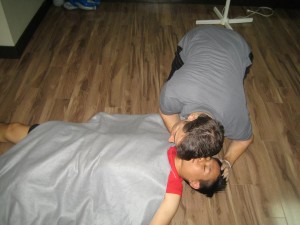Question: How is it possible to tell is someone is in anaphylactic shock?
Answer: To understand anaphylactic shock, you first need to realize that this is the most dangerous of allergic reactions that are out there. The blood pressure drops, leaving the brain without oxygen. There is inflammation in the lungs that result in being unable to breathe or at least shortness of the breath. The combination of the two elements can mean that this is deadly. In most cases, a person who has an allergic reaction is going to have itching and some wheezing, but with anaphylactic shock the results are devastating, and they often come along with other signs that people are not aware of.

There are two elements to keep in mind when identifying anaphylactic shock. First, you want to look at the symptoms the person has. Then you want to figure out what has caused this type of shock.
Symptoms of Anaphylactic Shock
There are symptoms of allergies that are going to be present with anaphylactic shock, including:
- Itching
- Hives
- Wheezing
In addition, consider these signs that are associated with low blood pressure, present when a person is suffering with anaphylactic shock:
- Confusion
- Weakness
- They may be pale
- Unconscious
When anaphylactic shock is present, the person may show shortness of breath, which is often found via these signs:
- The person cannot speak more than a couple of words
- They are sitting straight with their hands on their knees
- Gasping for air
- They are pushing their lips together to breathe
- You see their neck muscles being used to take breaths
Identify the Allergy
When a person goes into anaphylactic shock, it is easier to identify what has caused this if the person knows what they are allergic to. For example, a person allergic to bees often knows that they are allergic to bees. However, sometimes you may have to figure out what has caused this. You need to look at what the person was doing when they started to show symptoms. For example, if someone were eating, then you could conclude that they have a severe food allergy that they may not be aware of.
Treatment for Anaphylactic Shock
The treatment that you get is going to depend on how bad your allergic reaction is. For those who have a simple reaction, Benadryl is often given. For those who are having more severe reactions such as going into anaphylactic shock, then often times the person is going to require epinephrine.
